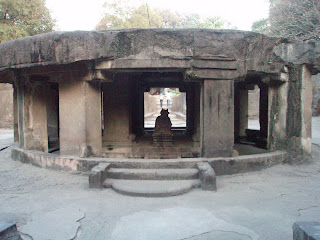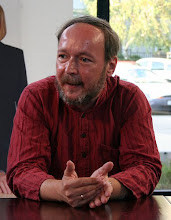
Located in the city of Pune in the Maharashtra state of India, Pataleshwar is not really a cave at all, but one of many modest examples of the Maharashtran temples carved from living rock.
The "cave" is a Shiva temple and out buildings carved of living basalt. The black rock has been carved into pillars, seating areas, rooms, and so on. Notable is the heart of the cave, a cube-shaped room about 3-4 meters on each side, that houses a lingam. Still in use, the lingam is anointed with ghee and yogurt. A brass temple bell hangs outside the basalt entryway.
Unlike other nearby 'caves' such as Ellora, Pataleshwar is fairly simple...there are a very few ornate carvings. (Retrieved from "http://en.wikipedia.org/wiki/Pataleshwar_cave")
The "cave" is a Shiva temple and out buildings carved of living basalt. The black rock has been carved into pillars, seating areas, rooms, and so on. Notable is the heart of the cave, a cube-shaped room about 3-4 meters on each side, that houses a lingam. Still in use, the lingam is anointed with ghee and yogurt. A brass temple bell hangs outside the basalt entryway.
Unlike other nearby 'caves' such as Ellora, Pataleshwar is fairly simple...there are a very few ornate carvings. (Retrieved from "http://en.wikipedia.org/wiki/Pataleshwar_cave")
Then I went to the Raja Dinkar Kelkar Museum.

The Raja Dinkar Kelkar Museum is in Pune, Maharashtra, India. It contains the collection of Dr Dinkar G. Kelkar (1896–1990), dedicated to the memory of his only son, Raja, who died early.
The collection was started around 1920 and by 1960 it contained around 15,000 objects. In 1962, Dr Kelkar handed his collection to the Department of Archaeology within the Government of Maharashtra.
The museum now holds over 20,000 objects of which 2,500 are on display. These consist of Indian mainly decorative items from everyday life and other art objects, mostly from the 18th and 19th centuries. There is a particularly fine collection of musical instruments. (http://en.wikipedia.org/wiki/Raja_Dinkar_Kelkar_Museum)

The Raja Dinkar Kelkar Museum is in Pune, Maharashtra, India. It contains the collection of Dr Dinkar G. Kelkar (1896–1990), dedicated to the memory of his only son, Raja, who died early.
The collection was started around 1920 and by 1960 it contained around 15,000 objects. In 1962, Dr Kelkar handed his collection to the Department of Archaeology within the Government of Maharashtra.
The museum now holds over 20,000 objects of which 2,500 are on display. These consist of Indian mainly decorative items from everyday life and other art objects, mostly from the 18th and 19th centuries. There is a particularly fine collection of musical instruments. (http://en.wikipedia.org/wiki/Raja_Dinkar_Kelkar_Museum)
Finally I visited the famous Aga Khan Palace, where Gandhi, his wife, Kasturba and his secretary were detained after the Quit India. Aga Khan Palace is situated in the Yerwada area of Pune. Sultan Mohammed Shah, Aga Khan III, had the palace constructed in the year 1892. The aim behind the construction of the Aga Khan Palace was to provide employment to the people of the nearby areas, who were hit by famine. Prince Karim El Husseni, Aga Khan IV, donated the palace to India in 1969, in the honor of Gandhiji and his philosophy. Aga Khan Palace is also known as Gandhi National Memorial because of its close association with Mahatma Gandhi.
One of the major attractions of the Aga Khan Palace is the samadhis (memorials) of Kasturba Gandhi (wife of Mahatma Gandhi) and Mahadev Desai (a long-time aide of Mahatma Gandhi). Since both of them breathed their last in here, Charles Correa had their samadhis built in the grounds of the palace itself. Gandhi's ashes are also interred at the Gandhi National Memorial of Poona. Exhibitions are held at the palace on a regular basis to acquaint people with the life and career of Mahatma Gandhi.
One of the major attractions of the Aga Khan Palace is the samadhis (memorials) of Kasturba Gandhi (wife of Mahatma Gandhi) and Mahadev Desai (a long-time aide of Mahatma Gandhi). Since both of them breathed their last in here, Charles Correa had their samadhis built in the grounds of the palace itself. Gandhi's ashes are also interred at the Gandhi National Memorial of Poona. Exhibitions are held at the palace on a regular basis to acquaint people with the life and career of Mahatma Gandhi.

The palace served as the venue for the famous movie Gandhi. Since 1980, the management of the museum, samadhis and campus of the Agakhan Palace is under the Gandhi Memorial Society. The museum inside the palace complex has rich collection of pictures, depicting almost all the important incidents in the life of Mahatma Gandhi. There is also a wide assortment of his personal items like utensils, clothes, mala, chappals (slippers), letter written by Gandhiji on the death of his secretary, etc.

No comments:
Post a Comment